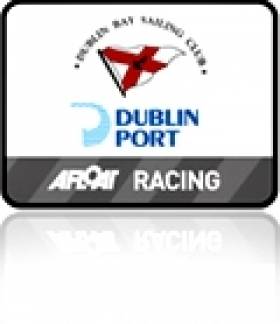Displaying items by tag: Theo Lyttle
Lyttle Triumphs in RStGYC Sail/Cycle Event
#rstgyc – The 3rd Cycle Superstore sponsored Sail/Cycle Challenge was held in the Royal St George Yacht Club last weekend in glorious weather conditions. The unique event comprises of a 60 km cycle over the Wicklow mountains with three time trials and three Laser races.
35 cyclists lined up in the club for the start of the cycle. The route took them over the Vico road towards Enniskerry village. Competitors were using the cycling app Strava to automatically log their individual times on each time trial segment. It was clear from the start that Neil O'Toole was fast and when the results came in, he had won the first leg by over a minute! O'Toole went on to win the next two time trials, followed closely by Gordon Judge and Helena Barrett. The route took cyclists up to the top of Glenncree and onwards over the Featherbeds, a total altitude gain of over 1000 metres.
On Sunday morning three Laser races were scheduled by PRO Frank O'Beirne. The format required that the races were a maximum of 30 minutes in length, so in less than 3 hours, three great races were sailed in sunny 10-15 knot conditions. Race one saw Sean Craig steal an early victory followed by Paul Keane and Theo Lyttle. Race 2 saw a complete change with Ross O'Leary leading from start to finish. Neil O'Toole, the clear favourite going into the sailing leg of the challenge, was placed 6th and a 7th throwing the competition wide open.
Going into the final race Craig, Keane, O'Leary and Lyttle were neck and neck for the sailing part of the competition and overall O'Toole and Lyttle had to battle it out for the trophy in the last race. Craig once again led around the windward mark only to be overtaken by Keane and Lyttle on the first run.
As the wind died down Lyttle squeezed ahead of Keane to win the Cycle Superstore Sail Cycle Challenge 2013.
Cycling Results
1. Neil O'Toole
2. Gordon Judge
3. Helena Barrett
4. Francis Barry
5. Theo Lyttle
6. Chris Arrowsmith
Sailing results
1. Theo Lyttle
2. Sean Craig
3. Paul Keane
4. Ross O'Leary
5. Dan O'Connell
6. Chris Arrowsmith
7. Neil O'Toole
8. Will Nesbitt
9. David Dwyer
10. Frank Heath
11. Richard Tate
12. Alain Deladienne
13. Pat O'Brien
14 Francis Barry
15 176280
16 John O'Keefe
Overall Winners
1. Theo Lyttle 11 points
2. Neil O'Toole 13 points
3. Chris Arrowsmith 23 Points
4. Frank Heath 32 points
5 Francis Barry 33 points
6 Richard Tate 35 points
Craig Outwits Lyttle for DBSC Dinghy Honours
In a fine turnout for the Laser class, the Royal St. George's Sean Craig outwitted club mate Theo Lyttle for line honours tonight in the Laser dinghy class on Dublin Bay.
Tonight was the last race in the first series of the Dublin Bay Sailing Club season.
The 13-boat Laser fleet – that race as part of the PY class – was double that of any other fleet tonight as 10–12 knot westerlies provided perfect dinghy sailing for the 30 dinghies competing. DBSC set triangular courses for all five classes.
It was ideal world championship practise for the six Fireballs now only ten days away from the world championships in Sligo. Continuing a theme Noel Butler and Steven Oram were winners again on Dublin Bay. Second was Winder (E.Butler/O.Laverty) and third Blind Squirrel (Frank Miller) of the DMYC.
In the PY race, Lyttle closed on Craig at the top of the second beat but downwind Craig extended again to take a comfortable margin by the line. Third was Paul Keane.
There is more good news for the Olympic single-hander in Dublin with reports that numbers for club racing are likely to increase as the DBSC Summer season progresses.
So far 21 Lasers are entered in total in a PY fleet of 28 boats.
The sailors involved in the rebirth of the Laser as a club boat include former Laser national class champion Chris Arrowsmith and tonight's race winner, the SB3 and Flying fifteen ace, Sean Craig. Former 420 champ Theo Lyttle is a regular as well as Gary O'Hare.
Full DUBLIN PORT Dublin Bay Sailing Club Results for 31 MAY 2011 results are below:
BENETEAU 31.7 - 1. Extreme Reality (P.McSwiney/E.O'Rafferty), 2. Attitude (D.Owens/T.Milner)
BENETEAU 31.7 - 1. Extreme Reality (P.McSwiney/E.O'Rafferty), 2. Attitude (D.Owens/T.Milner)
CRUISERS 2 - 1. Cor Baby (Keith Kiernan et al), 2. Free Spirit (John O'Reilly), 3. Graduate (D O'Keeffe)
CRUISERS 3 - 1. Chouskikou (R.Sheehan/R.Hickey), 2. Grasshopper 2 (K & J Glynn), 3. Pamafe (Michael Costello)
CRUISERS 4 - 1. Maranda (Myles Kelly)
FIREBALL - 1. nn (S Oram), 2. Winder (E.Butler/O.Laverty), 3. Blind Squirrel (Frank Miller)
GLEN - 1. Glendun (B.Denham et al), 2. Glenshesk (L.Faulkner et al), 3. Glencorel (B.Waldock/K.Malcolm)
IDRA 14 FOOT - 1. Dunmoanin (Frank Hamilton), 2. Doody (J.Fitzgerald/J.Byrne), 3. Squalls (Stephen Harrison)
MERMAID - 1. Tiller Girl (J.O'Rourke), 2. Lively Lady (G O'Neill & M Hanney), 3. Kim (D Cassidy)
PY CLASS - 1. Sean Craig (Laser), 2. T Lyttle (Laser), 3. P Keane (Laser 1)
RUFFIAN 23 - 1. Alias (D.Meeke/M.McCarthy), 2. Golden Girl (Michael Carrigan et al), 3. Diane ll (Bruce Carswell)
SQUIB - 1. Tais (Michael O'Connell), 2. Sidewinder (D.Croke/R.Bowen)





























































